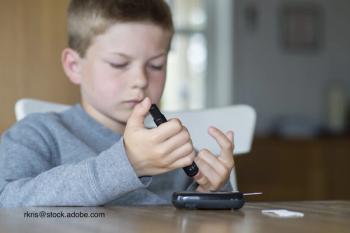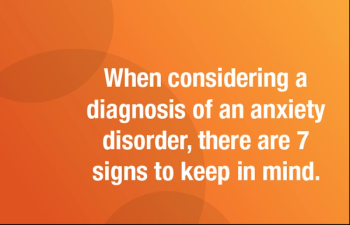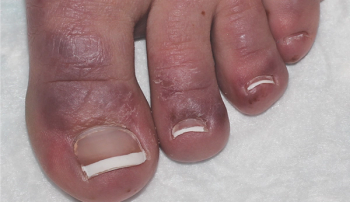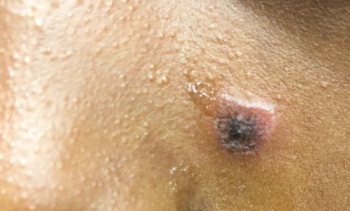
Children with ADHD often face other psychological or behavioral issues, and a new update to the clinical practice guidelines for the condition address how to manage them.

Children with ADHD often face other psychological or behavioral issues, and a new update to the clinical practice guidelines for the condition address how to manage them.

For years, researchers have raised concerns about acetaminophen use during pregnancy, now a new study that used cord blood to measure acetaminophen levels at birth links the commonly used medication to later ADHD and autism diagnoses.

Patients with diabetes have an increased risk of developing depression. A new study in Pediatric Diabetes, however, takes this one step further, suggesting that depressive symptoms among youths with diabetes varies by diabetes type.

Affecting between 15% to 20% of children and adolescents, anxiety disorders are the most prevalent psychiatric condition in pediatrics. The impact can be significant with difficulties in social and academic functioning as well as increased risk for other mental health concerns. However, it can be difficult for a clinician to differentiate between anxiety and an anxiety disorder. Here are 7 signs to help make the diagnosis.

A healthy 15-year-old girl presents for evaluation of itchy, painful bumps on her toes that developed 3 weeks earlier. The bumps become more numerous and bothersome when she is outdoors sledding and skiing. What's the diagnosis?

A new nationwide program helps primary care providers (PCPs) with mental health training to better address routine psychosocial issues in children and their families.

A healthy 10-year-old male presents for evaluation with a 3-year history of an asymptomatic and progressive, mildly pruritic rash over his head and trunk. The first lesion appeared on his back 3 years ago, and numerous other lesions developed insidiously afterward. The patient’s father states that the lesions fade during the winter and become more prominent during the summer. Failed treatment included hydrocortisone. What's the diagnosis?

E-cigarette use continues to be popular among middle and high school children, according to a new study published in JAMA. Flavored e-cigarettes are popular among them as well.

As state policies regarding vaccination for children entering kindergarten eliminate exemptions for personal beliefs, parents turn to claiming exemptions on religious grounds.

Using antibiotics for extended periods in preterm infants can have long-term damaging effects to their gut microbiota, according to a recent study.

Expert discusses the rationale on shift from 60 years of practice regarding intravenous (IV) maintenance fluid therapy.

Children are highly susceptible to advertising, and it’s getting more difficult to recognize advertising for what it is and protect children from it. Take a look at tech tricks in mobile advertising and ways to avoid them.

Pediatricians often focus on nutrition, but educating parents about food additives and safety should be included.

For many of us in pediatrics, depression and other related diagnoses can present a challenge. Our counterparts who treat adults see and treat depression more often and are often more comfortable with both diagnosis and treatment. It's time to work on this.

What to do when the baby cries; how to get the diaper on just right; or bathing baby may seem like the top concerns of new fathers, but experts say confidence and support are the real deficits for fathers-to-be.

During the Opening Plenary Session of the American Academy of Pediatrics in New Orleans, Lousiana, US Supreme Court Justice Sonia Sotomayor described her experience with the diagnosis, hospitalization, and the life-changing impact of managing type 1 diabetes.

Experts seek to clear confusion, trepidation about concussion identification and management.

Even if it’s not your personal choice, pediatricians need to know how to talk to parents and patients about body art.

Whereas hormone prescribing for transgender or gender diverse children and teenagers may be a specialty, primary care pediatricians are often the first-line provider families turn to for support and guidance.

Every child is one caring adult away from being a success story, according to Josh Shipp, a nationally recognized youth empowerment expert and author. Mr. Shipp made the comments during a keynote address during the 2019 American Academy of Pediatrics National Conference & Exhibition in New Orleans, Louisiana.

The American Academy of Pediatrics (AAP) reminds its members not to be content with 2019’s achievements in children’s health, but to stand up against new challenges that threaten to undo what already has been won.

One of the most frustrating elements of medicine, for patient and pediatrician alike, is the cost of medication -- and the often-inscrutable reasons for that cost. At the final plenary session for October 27, 2019, at the 2019 American Academy of Pediatrics National Conference & Exhibition, John D. Lantos, MD, director at the Bioethics Center and professor of pediatrics at the University of Missouri Kansas City School of Medicine, presented on the high costs of medication, the ethical conundrums the costs can create, and what the pediatrician can do in practice to help combat.

In a session at the American Academy of Pediatrics 2019 National Conference & Exhibition, Ellen R. Wald, MD, FAAP, Chair of the Department of Pediatrics at the University of Wisconsin School of Medicine and Public Health and Pediatrician-in-Chief of the American Family Children's Hospital, in Madison, covered the latest guidance for diagnosing and treating the condition.

Expert offers guidance on helping parents and teenagers make it through adolescence.

A useful tool in some regards, clinicians should use caution in posting and interacting with patients online.

Troubled children often become troubled adults, but pediatricians can help to stop the cycle by promoting resilience and offering support to both patients and their caregivers.

Tiffani Johnson, MD, MSC, FAAP, enthralled a packed room at the American Academy of Pediatrics 2019 National Conference & Exhibition Friday afternoon when she led session attendees to admit that they harbor many hidden biases and discriminatory attitudes toward patients and families that can unconsciously determine how they treat patients, parents, and even office staff.

It’s one of the scariest moments that a pediatrician will face in his or her career: a medical error or preventable adverse event. Here is some practical advice on how to manage this event.

After assessing a child who is presenting with some type of infectious disease, the next step is to run a diagnostic test, such as a rapid strep test or measles. However, is that always the best decision?

With multiple patients to see and many government mandates to fulfill, the pediatrician's life is a busy one. Here are 5 apps to help you work smarter.